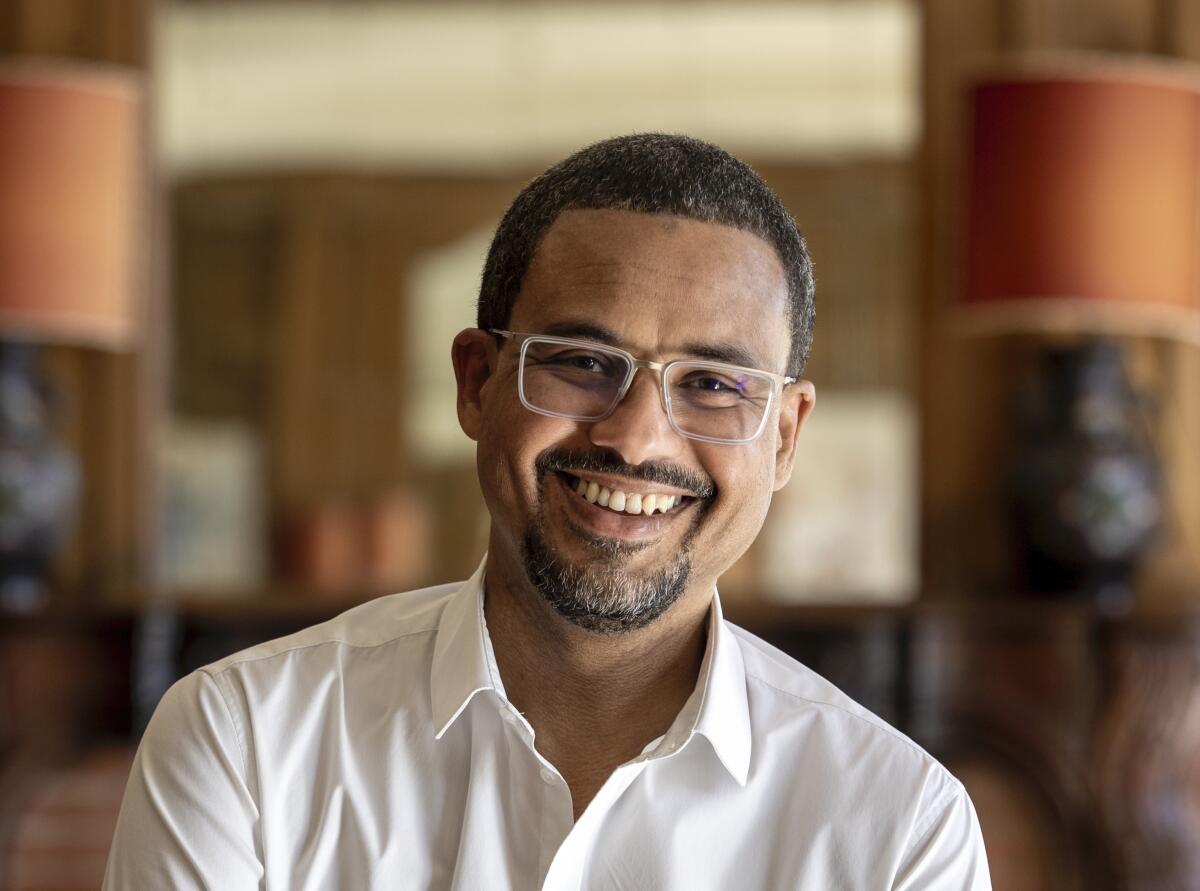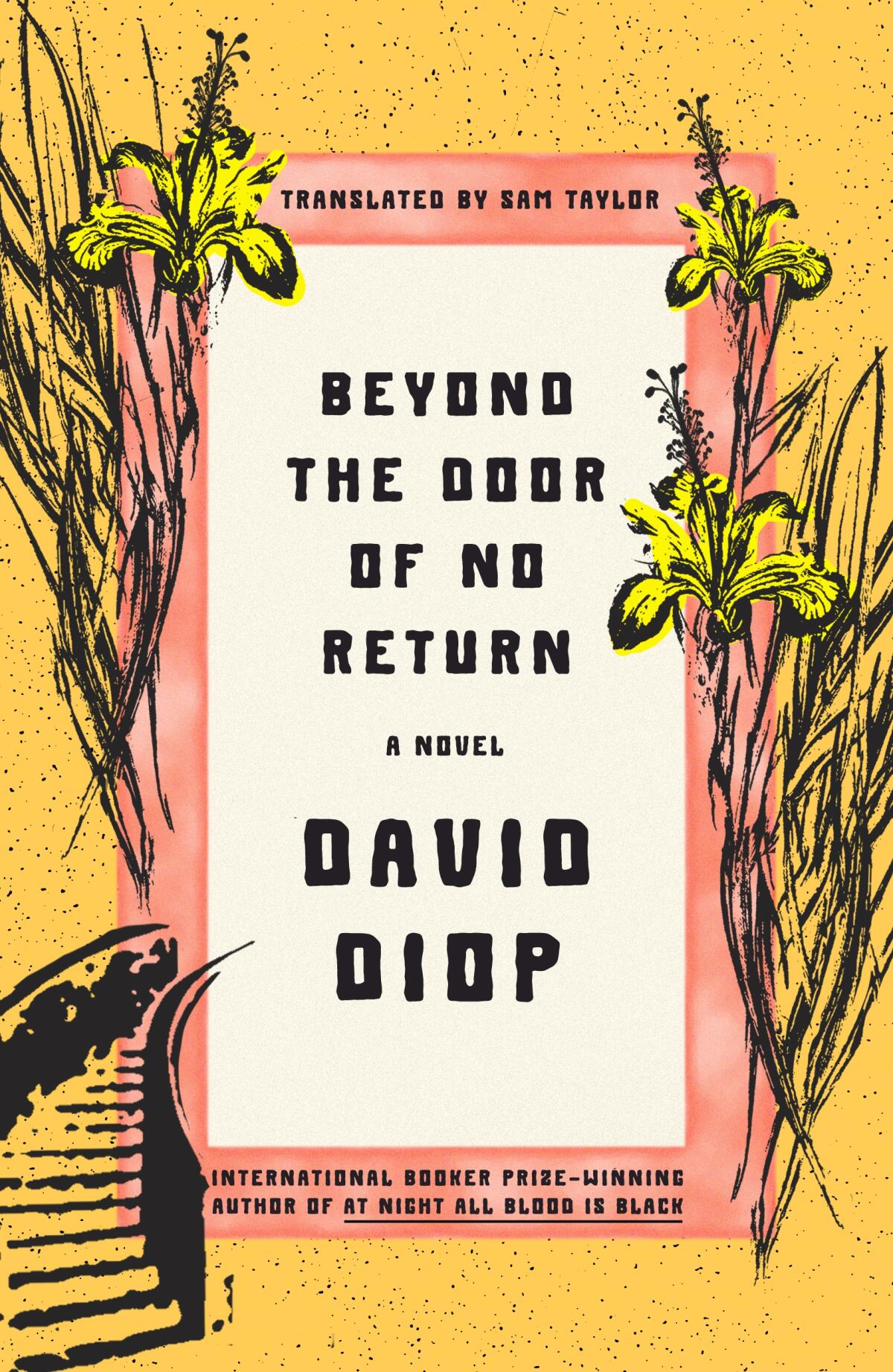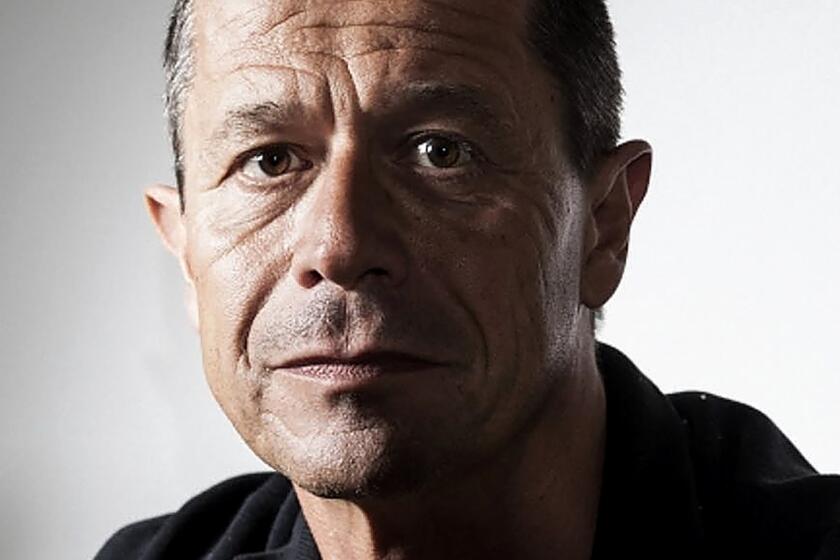The National Book Awards’ translated-lit longlist is here. Of course David Diop is on it

- Share via
On the Shelf
Beyond the Door of No Return
By David Diop, translated by Sam Taylor
FSG: 256 pages, $27
If you buy books linked on our site, The Times may earn a commission from Bookshop.org, whose fees support independent bookstores.
In 2021, a slim, incantatory novel about a West African Allied regiment in World War I won the International Booker Prize, and the world was introduced to 55-year-old French Senegalese author and scholar David Diop. For French readers the book, “At Night All Blood Is Black,” also provided an introduction to a little-known aspect of their own history.
On Wednesday, the National Book Foundation announced its longlist for translated literature. (See full list below.) The 10 nominated authors span a wide range of nations and styles, including Germany’s Jenny Erpenbeck (“Kairos”), Colombian author Juan Sebastián Cárdenas (“Devil of the Provinces”), Mexico’s Fernanda Melchor (“This Is Not Miami”) and Korean surrealist Bora Chung (“Cursed Bunny”). Among them, of course, is Diop, for his second novel, out next week in the U.S.: “Beyond the Door of No Return.”
Diop’s second novel digs even deeper than his debut into the past to explore the relationship between an 18th century French botanist, Michel Adanson, and Maram Seck, a formerly enslaved woman in Senegal. Diop masterfully teases out Adanson’s tale of youthful adventure and awakening. “I made the voyage to Senegal to discover plants,” Adanson recalls, “and instead I encountered people.”
Deesha Philyaw, Victoria Chang and Isabel Wilkerson are among the winners of the 2020 L.A. Times Book Prizes, announced Friday.
Diop has again exposed a neglected corner of the French colonial experience, expanding the country’s literary conversation at a time of heated debate over national identity and culture. As Adanson reflects, “Only fiction, the novel of a life, can give a genuine glimpse of its profound reality, its complexity; only fiction can illuminate its darkest corners.” Diop spoke with The Times over email about his new book and its historical inspirations.

Where are you and where have you been this summer? It’s been another explosive one, and not only in France.
I live and work in Pau, a city in the southwest of France. This summer I went to Rome for the launch of the Italian translation and to Marseille to visit one of my sons. In truth, France isn’t more explosive than anyplace else in the world right now. There is a looming threat that knows no borders — and that strikes me as a probable cause of many of the social and political upheavals we’re seeing around the world. That threat is the destabilization of the climate.
Your previous novel came out here in the midst of the pandemic and had a somewhat quiet reception — until it won the International Booker Prize. Did that award have an immediate impact on you?
Well, I should point out that I also won the Los Angeles Times Book Prize for fiction in April of that year! And so I found the reception of “At Night All Blood Is Black” to be very positive even before the Booker was announced. That being said, it did bring my work as a novelist to the attention of a much bigger audience around the world — something that makes me very happy, as it’s allowed me to interact with readers from a multitude of different cultural backgrounds.
Tell me about your new novel. What was the impetus of the story and how does it intersect with your academic interests?
I first encountered the historical figure who inspired the novel roughly 15 years ago. At the time, one of my research interests was 18th century African travelogues written by Europeans. It was then that I stumbled across Michel Adanson’s captivating “A Voyage to Senegal,” published in Paris in 1757. He describes the people of Senegal with a remarkable eye for detail, certainly by the standards of his era. Adanson eventually joined the French Academy of Sciences, and in his younger self I found an openness of spirit, an original sort of intellectual curiosity — these traits were what made me want to turn him into a character in a work of fiction.
‘Yoga’ charts true-crime master Emmanuel Carrère’s journey from intensive meditation to mental breakdown — but leaves out the divorce that derailed him.
Did you set out to take a substantially different perspective than other writers who have covered this period?
I didn’t have a clear sense of this when I first began writing. One of my ideas was to place a figure from the Age of Enlightenment, a humanist, in a sort of psychic disequilibrium. In the book, Adanson is confronted with all the cultural riches of West Africa — riches that were generally devalued by his contemporaries. He’s also confronted with the harsh reality of transatlantic slavery. The novel as a literary genre allowed me to evoke the complexity of the dilemmas faced by human beings during periods of change and unrest, when their ideals were crushed by the weight of reality.
How much of the novel is based on real figures — including Adanson — and how much did you choose to invent? I’m especially interested in the enigmatic “revenant,” Maram, who becomes a local healer after escaping from slavery.
Adanson, of course, really existed. In addition to writing “A Voyage to Senegal,” he also compiled the first French-Wolof dictionary, which is preserved with his papers at the [National] Museum of Natural History in Paris, and which has never been published. As for Maram Seck, she’s entirely my own invention, though her character was inspired by a real individual. This person was in fact the crown prince of a kingdom in what is now the Gambia. He purportedly managed to return to the kingdom after being enslaved for several years in Maryland and later England in the 1730s. A story such as this one would have been highly unusual in the 18th century, to say the least.
What did you want to explore in the individual stories?
I sought to make Adanson and Seck representative of their two respective worlds. Or, to be more precise, two conceptions of the relationship between human beings and the natural world, which today might seem irreconcilable to us. Adanson is a scientist, convinced that human reason is all-powerful. He is a botanist in the mold of Descartes, who famously wrote that we should pursue knowledge in order to become the “masters and possessors of nature.” Maram doesn’t seek to exploit or subjugate nature but to work with it and through it. By bringing [them] together — however briefly — I wanted to use fiction to redeem a missed opportunity to reconcile these two visions of the world.
This article was originally on a blog post platform and may be missing photos, graphics or links.
Have your books helped prompt discussions in France about its complicated past? And do you see them as part of a larger literary trend reckoning with French history?
As I see it, literature operates on the plane of emotion, whereas history, as a discipline, aims to objectively explain the past. My intention isn’t to offer a history lesson. Instead, I situate my characters in what can seem like a challenging historical context — the period when France controlled a colonial empire — without resorting to caricature or engaging in polemic. For me, what makes a character interesting is the complexity of the choices they must make during periods of historic turmoil. I try to tease out, from the particularity of their personal experiences, what is eternally human: love, friendship, death.
The 2023 Longlist for the National Book Award for Translated Literature
Juan Sebastián Cárdenas, Devil of the Provinces
Translated from the Spanish by Lizzie Davis
Bora Chung, Cursed Bunny
Translated from the Korean by Anton Hur
David Diop, Beyond the Door of No Return
Translated from the French by Sam Taylor
Jenny Erpenbeck, Kairos
Translated from the German by Michael Hofmann
Stênio Gardel, The Words That Remain
Translated from the Portuguese by Bruna Dantas Lobato
Khaled Khalifa, No One Prayed Over Their Graves
Translated from the Arabic by Leri Price
Fernanda Melchor, This Is Not Miami
Translated from the Spanish by Sophie Hughes
Pilar Quintana, Abyss
Translated from the Spanish by Lisa Dillman
Astrid Roemer, On a Woman’s Madness
Translated from the Dutch by Lucy Scott
Mohamed Mbougar Sarr, The Most Secret Memory of Men
Translated from the French by Lara Vergnaud
Tepper is curator of international literature at City of Asylum in Pittsburgh.
More to Read
Sign up for our Book Club newsletter
Get the latest news, events and more from the Los Angeles Times Book Club, and help us get L.A. reading and talking.
You may occasionally receive promotional content from the Los Angeles Times.







